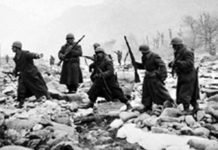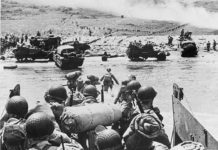The Great Sioux War started over who controlled the Black Hills. A flawed battle plan ensured bloodshed on both sides, including that of George Custer.
The Indian Wars had remained fairly quiet from 1868-75 on the northern plains as a result of the Fort Laramie Treaty. The treaty recognized that the Sioux retained rights to a large swath of land in Wyoming and Montana (unceded land). They could use it for hunting and roaming without any white incursion provided their permanent residence was on the Great Sioux Reservation set up by the government in South Dakota. It was also understood that the reservation itself, including the Black Hills, was under sole ownership of the Sioux.
Not all bands abided by the treaty. Some never lived on the reservation at all. Others resided there only during the winter to receive their government allotments and then returned to their hunting territory in the summer. The discovery of gold in the Black Hills in 1874 induced the United States to use this arrangement to change the rules on the Sioux.
Greed, Broken Treaty, and War
President Ulysses Grant wrestled with breaking the Ft Laramie Treaty or trying to stem the tide of white prospectors illegally rushing to the area. He settled on picking a fight with the Sioux as justification for taking the Black Hills away from them. Rather than invoking violence against Indians on the reservation, he instead pursued those hunting game in their unceded lands under the guise that they were harassing white settlers outside the boundaries established by the treaty. An ultimatum was made to the nomadic bands of Indians to return to the reservation by January 1, 1876 or face consequences. The roaming Sioux ignored Grant’s demand. So began the Great Sioux War.
On February 8, Grant ordered his commander of the Military Division of the Missouri, Major General Phil Sheridan, to devise a plan to secure the Black Hills for the United States. Sheridan, in turn, directed his two department commanders in the field, Brigadier Generals Alfred Terry and George Crook, to prepare for a winter offensive against the roaming Indians. During that time of the year, it was assumed that many of them would return to the reservations for their government allotments and to wait out the cold weather thus decreasing the number of potentially hostile individuals to deal with. The roamers were also less mobile in winter which made them easier to find and attack.
Setting the Stage for the Great Sioux War and Custer’s Demise
A three-pronged pincer offensive was planned. Crook’s column would move northward through Wyoming. Terry would coordinate movements of a column under Colonel John Gibbon travelling eastward along the Yellowstone River and Lieutenant Colonel George Custers men moving westward from North Dakota, also towards the Yellowstone.
When Gibbon, Terry and Custer met up, they would catch the roaming Sioux Indians between themselves and the northward advance of Crook. The campaign’s design carried many similarities to the one that was used to successfully defeat the Indians in the Southern Plains War of 1868-69. However, serious complications would arise due to the large area of operations, cold and snowy weather, lack of sustained and reliable communication between the columns, and absence of a unified commander in the field coordinating the movements of each force.
The reality of the winter campaign was that only Crook was able to mobilize his column by March 1, 1876. Gibbon was delayed gathering his men scattered across a vast landmass to a staging area for the formation of his column. He did not take to the field from Ft Ellis until April 1. Terry was held up by nasty weather and waiting for Custer to return to North Dakota from a five month leave of absence. The last to column to depart, they were finally underway on May 17.
Though in the field, Crook would soon be beaten back to Ft Fetterman, Wyoming by cold, starvation, and the ineffectual Battle of Power River. The delay of the other two columns allowed more freedom of movement by the nomadic Indian bands later in the spring. The warmer weather also gave the Indians on the reservation a chance to join their brothers in battle. These ramifications would prove pivotal in several disastrous engagements later in the year including the famed Battle of the Little Bighorn.








